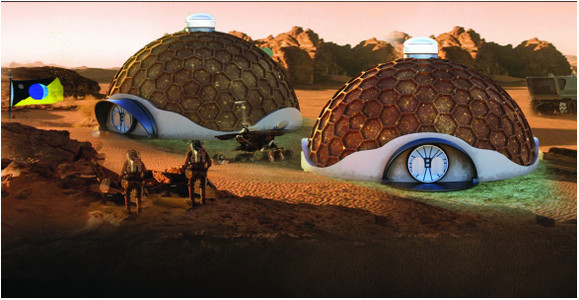Construction Tips, News & Best Practices
The Challenges of Space Construction
What needs to be done to make a living in Space possible? How may habitat on Mars look like? And what are the differences between the Moon and Earth architecture? In this article, we will give voice to experts from the space industry and learn all the secrets of Space Exploration!
Have you ever dreamt of living on a different planet? Or have you ever imagined what it would look like? In the 21st century, Space Exploration becomes a fact, and the reality of creating the first habitats and living on Mars is no longer an unrealistic dream!
For many of us, Space Exploration still remains something mysterious and fascinating at the same time. That is why, in today's article, we want to lift the veil on the secrets of this industry and give voice to professionals Aastha Kacha and Vittorio Netti, who work in the Space Industry and know the best of its reality, challenges and crucial milestones.
What are the Biggest Challenges for Space Exploration?
Space exploration is itself a challenge, but there is a saying, if there is something important to you, you go all the way.
- Aastha Kacha
We can categorise the challenges of Space Construction based on the parts of the Space Mission. In the first stage, the transportation system for travel between Earth and Moon or Mars, we can highlight the challenges such as: taking off against gravity, navigation in Space, isolation of astronauts, the risk of a crash during the landing. Then once on the planet, there are several technical problems like building a habitat, generating electricity or using multiple systems. However, this is not the end of challenges yet! Astronauts also need to protect the habitat from asteroids or space debris as the significant number of the latter creates a constant threat to international space stations.
However, when we think of Space Exploration, another huge challenge is not explicitly connected with a mission. It is the cost. To enable a sustainable and accessible space environment for humans, we need to increase automation, reusability, safety and lower the cost of access to Space.
‘’We will not manage to become a multi-planetary species if human spaceflights are not as easy and inexpensive as atmospheric civil flight.’’ - Vittorio Netti.
Living In Space - How to Make It Possible?
To make a living in Space (Mars or Moon) possible, we need to consider various aspects. Based on the challenges mentioned above, specialists working in the Space Industry need to reinvent all the elements of the construction process. Buildings need to be created from raw, local materials found on the planet, as we cannot transport all materials there from Earth. Construction techniques and machinery need to change as well as building in different conditions and gravity.
When astronauts make the first steps on Mars, their habitats need to be already fully built and working. We can not expect them to build houses just after six months of travel in microgravity conditions. However, for now, we cannot control the construction machinery directly from Earth as the distance from Earth to Mars results in a 12-20 minutes delay in the communications.
How to Design a Proper Space Habitat?
‘’Space Architecture is the theory and practice of designing and building for outer Space, including diverse disciplines such as sociology, psychology, physiology. Any space habitat's primary objective is to protect the crew from the exterior environment and comfort the crew by providing an earth-like environment. There is no room for error, and they should be easy to repair or maintain.‘’
- Aastha Kacha
But how can we make an earth-like environment in a place utterly different from the conditions we are used to on Earth? To do that, a space architect needs to combine many various aspects. A space habitat needs to store all necessary equipment, laboratories, systems, but also correspond to the human needs with sleeping quarters, toilets, communication room, gym or even a greenhouse, where they can commune with nature.

Space Habitat visualisation created by AAKA Space Architects
Space vs Earth Architecture
What are the Differences Between Space and Earth Construction?
In space architecture, we identify two different construction environments, characterised by very different environmental conditions: space (orbital or deep space) and planetary.
The first one is strongly connected with building in space, for example, in the International Space Station. Creating any building project requires considering aspects such as microgravity conditions, constant exposure, space radiation, micrometeoroids and debris.
Planetary space construction may at first glance seem similar to earth-based construction. However, there are some crucial differences, like gravity conditions (1/6 on the Moon, 1/3 on Mars) or constant radiation exposure.
In both types of space architecture, we need to remember the psychological aspect as astronauts (as well as the people living in the habitats in the future) will need to spend months or even years without the possibility to experience the open air, smell and earth sounds.
How are Space and Earth Construction connected?
Designing and building in an entirely different and demanding environment (lack of water, different gravity, risk of asteroids) pushes space architects to look for some innovative solutions. Even though some of them may, in the end, not be used during the space mission, they can have a great use on Earth, making the construction process more efficient and eco-friendly.
On Mars, we will have to recycle everything as that will help to generate resources to continue human life, which is eventually helping to develop advanced recycling systems on Earth. Also, learning about creating habitats on Mars gives us crucial knowledge on how to build with less water usage (which can be essential in terms of environmental changes on Earth).
Despite apparent differences, Earth and Space Construction are closely related. When we take a look at a construction project and a space mission, there are many similarities. In both of them, we can observe the use of new technologies like 3D printing, BIM or drones. Also, AI (Artificial Intelligence) and Big Data are emerging trends nowadays. Both sectors rely more and more on online solutions that digitise the processes. Transferring these technologies and crucial data results in more profound innovation and a faster move towards the future of construction.
Earth architecture and construction are already affected by the space environment since the start of human space exploration. Apollo missions inspired generations of architects and engineers, from Kisho Kurokawa to Buckminster Fuller. Many modern technologies have been proven valid in both fields, which is now called technological transfer.
- Vittorio Netti
Future of Space and Earth Construction
’Today, space architecture is a very specialised subject and it is emerging. It does not limit itself to one set of prefixed rules. It challenges us to extend our creativity and imagination to find the pathway from the impossible to the possible. It also pushes us to thoroughly find solutions on how extreme environments affect architecture and its users!‘’ - Aastha Kacha
How about you? Does Space Exploration still sound to you like a Sci-Fi movie or do you see it as a not-so-distant future?
Space Construction and Space Exploration may remain futuristic and mysterious, but it is worth taking a closer look at it for anybody from the construction industry. Of course, commercial flights will be possible in the distant future (due to the cost, challenges and lack of sufficient infrastructure). Still, Space Exploration strongly impacts trends, innovations and technology we use, also on Earth! And after all, knowing about future trends can be a significant factor in gaining an advantage in the market!
If you want to read more about Space Exploration, check out those articles:
Also, read more about how technology can support the future of construction!
Meet our interviewees:


You might also like
February 29, 2024 • 7 min read
Utilizing the human-first approach to construction projects to drive higher results.
July 3, 2023 • 6 min read
8 Best Construction Drawing Management Software (2023): A Comprehensive Guide
Find all the information you need about the construction drawing management software tools available on ...June 14, 2023 • 6 min read
The 11 Best PlanGrid Alternatives (2023)
Looking for a great alternative to PlanGrid software? Check out the 11 best construction software tools ...June 14, 2023 • 4 min read
How to win at CIS 340 and make taxes a breeze
CIS 340 is a legal obligation for contractors. But getting it right isn’t straightforward. Want ...





